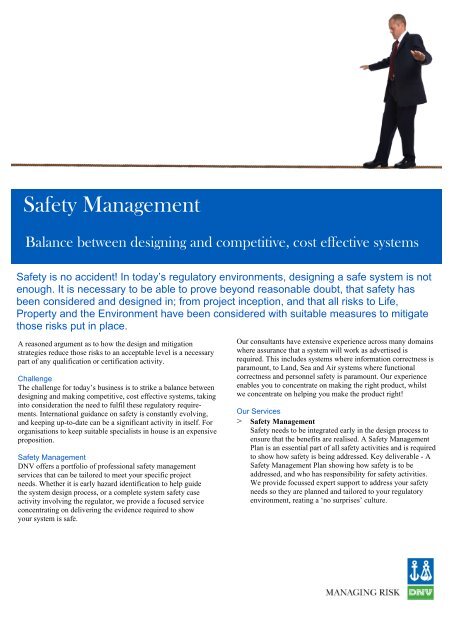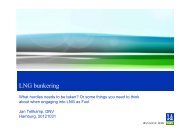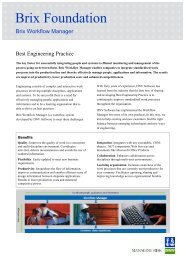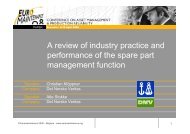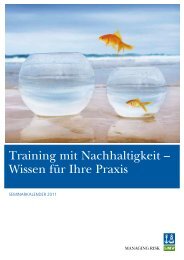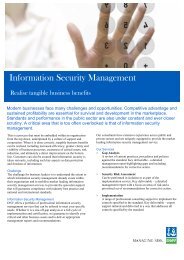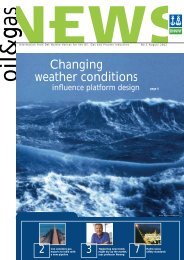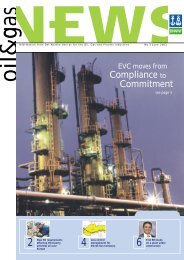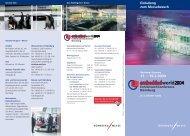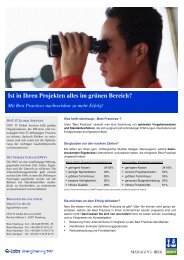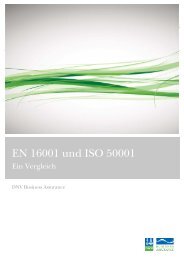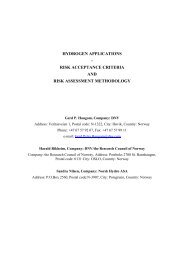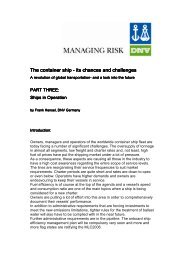Safety Management v0.1 - DNV Germany
Safety Management v0.1 - DNV Germany
Safety Management v0.1 - DNV Germany
Create successful ePaper yourself
Turn your PDF publications into a flip-book with our unique Google optimized e-Paper software.
<strong>Safety</strong> <strong>Management</strong><br />
Balance between designing and competitive, cost effective systems<br />
<strong>Safety</strong> is no accident! In today’s regulatory environments, designing a safe system is not<br />
enough. It is necessary to be able to prove beyond reasonable doubt, that safety has<br />
been considered and designed in; from project inception, and that all risks to Life,<br />
Property and the Environment have been considered with suitable measures to mitigate<br />
those risks put in place.<br />
A reasoned argument as to how the design and mitigation<br />
strategies reduce those risks to an acceptable level is a necessary<br />
part of any qualification or certification activity.<br />
Challenge<br />
The challenge for today’s business is to strike a balance between<br />
designing and making competitive, cost effective systems, taking<br />
into consideration the need to fulfil these regulatory requirements.<br />
International guidance on safety is constantly evolving,<br />
and keeping up-to-date can be a significant activity in itself. For<br />
organisations to keep suitable specialists in house is an expensive<br />
proposition.<br />
<strong>Safety</strong> <strong>Management</strong><br />
<strong>DNV</strong> offers a portfolio of professional safety management<br />
services that can be tailored to meet your specific project<br />
needs. Whether it is early hazard identification to help guide<br />
the system design process, or a complete system safety case<br />
activity involving the regulator, we provide a focused service<br />
concentrating on delivering the evidence required to show<br />
your system is safe.<br />
Our consultants have extensive experience across many domains<br />
where assurance that a system will work as advertised is<br />
required. This includes systems where information correctness is<br />
paramount, to Land, Sea and Air systems where functional<br />
correctness and personnel safety is paramount. Our experience<br />
enables you to concentrate on making the right product, whilst<br />
we concentrate on helping you make the product right!<br />
Our Services<br />
> <strong>Safety</strong> <strong>Management</strong><br />
<strong>Safety</strong> needs to be integrated early in the design process to<br />
ensure that the benefits are realised. A <strong>Safety</strong> <strong>Management</strong><br />
Plan is an essential part of all safety activities and is required<br />
to show how safety is being addressed. Key deliverable - A<br />
<strong>Safety</strong> <strong>Management</strong> Plan showing how safety is to be<br />
addressed, and who has responsibility for safety activities.<br />
We provide focussed expert support to address your safety<br />
needs so they are planned and tailored to your regulatory<br />
environment, reating a ‘no surprises’ culture.
Our Services<br />
> Hazard Identification<br />
This can be performed in isolation or as part of the safety<br />
case service. A number of techniques are used depending on<br />
your needs, system and operating environment. Key<br />
deliverable - a document identifying all hazards associated<br />
with your system. This can be expanded to include the<br />
criticality of those hazards, as well as mitigation strategies<br />
to influence the early design.<br />
> <strong>Safety</strong> Case production<br />
A safety Case is your reasoned argument as to why the<br />
system is safe for its intended use. It draws on many<br />
activities from the safety management culture, the systems<br />
analysis, its intended use and operating environment, to<br />
show you have taken reasonable steps to meet your safety<br />
commitment. It is important that the regulator is included in<br />
the journey of the production of the case, and agrees the<br />
arguments as they are put forward.<br />
> Key deliverable<br />
An agreed safety case for your system that identifies the<br />
hazards and mitigations put in place for its intended<br />
operation.<br />
> Independent <strong>Safety</strong> Case evaluation<br />
Some equipments are developed by partners and come with<br />
a safety case. In these circumstances, it is important that the<br />
evidence provided with the equipment stands up to scrutiny<br />
and shows its operation to be safe in its intended role. This<br />
activity aids integration, ensuring at an early stage that the<br />
overall system safety objectives of your system can be met.<br />
Key deliverable - A report independently reviewing the<br />
safety case provided, highlighting any shortcomings, with<br />
recommendations for activities to address those<br />
shortcomings.<br />
> Independent <strong>Safety</strong> Audit<br />
<strong>Safety</strong> is a trust issue, and in a regulatory environment it is<br />
essential to ensure that safety has not only been implemented,<br />
but that it has been seen to be implemented. An<br />
Independent <strong>Safety</strong> Auditor is an experienced safety<br />
practitioner who maintains and independence from the<br />
safety and design teams.<br />
<strong>DNV</strong> IT Global Services<br />
WWW.<strong>DNV</strong>.COM/ITGS<br />
itgs@dnv.com<br />
They provide that essential level of trust that shows that a<br />
safety culture runs through the complete development<br />
cycles of your product. Key deliverable - Ongoing<br />
involvement in the design process, culminating in an audit<br />
report highlighting where things are going right, and<br />
where further attention needs to be concentrated.<br />
Your Benefits<br />
1. A scalable process that allows you to concentrate on your<br />
main goal, a successful safe product<br />
2. Gives you confidence that the design, development and<br />
operation of your system has the safe control of hazards as<br />
the foundation of all your subsequent activities<br />
3. Thorough and rigorous processes to allow early<br />
identification of those hazards that are inherent in your<br />
system<br />
4. Experts that speak the language of your regulator, taking<br />
them with you on the design journey - no surprises<br />
5. Business process improvement by the integration of<br />
assurance processes into the design activity<br />
6. Improved efficiency - early identification means less<br />
rework later in the cycle<br />
7. Compliance with the standard<br />
8. Confidence that suppliers equipment will work safely<br />
when integrated and operating in your system<br />
More Information<br />
If you have any questions or want more information, please<br />
contact us by e-mail: itgs@dnv.com.<br />
<strong>DNV</strong> has local IT Global Services offices in China, <strong>Germany</strong>,<br />
France, Italy, Netherlands, Sweden, UK and USA. Find the<br />
local office near by you at WWW.<strong>DNV</strong>.COM/ITGS or visit the site<br />
for more information on this subject.


